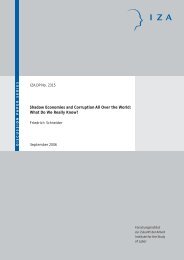Health Outcomes and Socio-Economic Status among ... - Index of - IZA
Health Outcomes and Socio-Economic Status among ... - Index of - IZA
Health Outcomes and Socio-Economic Status among ... - Index of - IZA
You also want an ePaper? Increase the reach of your titles
YUMPU automatically turns print PDFs into web optimized ePapers that Google loves.
for whom over 60% have no schooling. Even for men, nearly half <strong>of</strong> the sample did not<br />
complete primary school, though the fractions that did complete primary <strong>and</strong> junior high school<br />
<strong>and</strong> above are much higher for men. In Gansu, the sample is two-thirds rural, while in Zhejiang<br />
just over half are urban.<br />
3. Results<br />
BMI<br />
We first examine body mass index (BMI), which is measured as weight (in kg) divided<br />
by height squared (in meters). Extreme values <strong>of</strong> BMI may be related to hypertension, diabetes<br />
<strong>and</strong> in general to higher adult mortality (Waaler, 1984). Across countries, the BMI distribution<br />
is shifted to the right for countries with higher incomes. Figure 1, which is reproduced from<br />
Strauss <strong>and</strong> Thomas (2008), demonstrates this, showing nonparametric relationships between<br />
BMI <strong>and</strong> years <strong>of</strong> schooling, for men <strong>and</strong> women aged 25-70 from 6 countries, ranging in GDP<br />
from Bangladesh to the United States. 13 China as <strong>of</strong> 1991 is included <strong>among</strong> these six countries<br />
<strong>and</strong> is closest in its BMI distribution to Indonesia. Note that for men, except in the US, BMI<br />
rises with more education. For women the story is quite different. Again, the US excepting <strong>and</strong><br />
also for low levels <strong>of</strong> schooling for women, BMI rises with education, but at higher levels, it<br />
falls. Bangladesh is an exception, BMI rises with female schooling, probably because women<br />
are still so close to levels <strong>of</strong> undernutrition. In the other developing countries, including China,<br />
the inverted U-shape relation is apparent. It may be that at higher levels <strong>of</strong> female schooling,<br />
women recognize the health benefits <strong>of</strong> reducing their BMI. Why not men is a key question for<br />
future research.<br />
13 The sources are the Matlab <strong>Health</strong> <strong>and</strong> <strong>Socio</strong>economic Survey, 1996; the China <strong>Health</strong> <strong>and</strong> Nutrition Survey,<br />
1991; the Indonesia Family Life Survey, 2000; the South African Demographic <strong>Health</strong> Survey, 1998; the Mexican<br />
Family Life Survey, 2002 <strong>and</strong> the NHANES3 (National <strong>Health</strong> <strong>and</strong> Nutrition Examination Survey III), 1988-1994.<br />
15
















